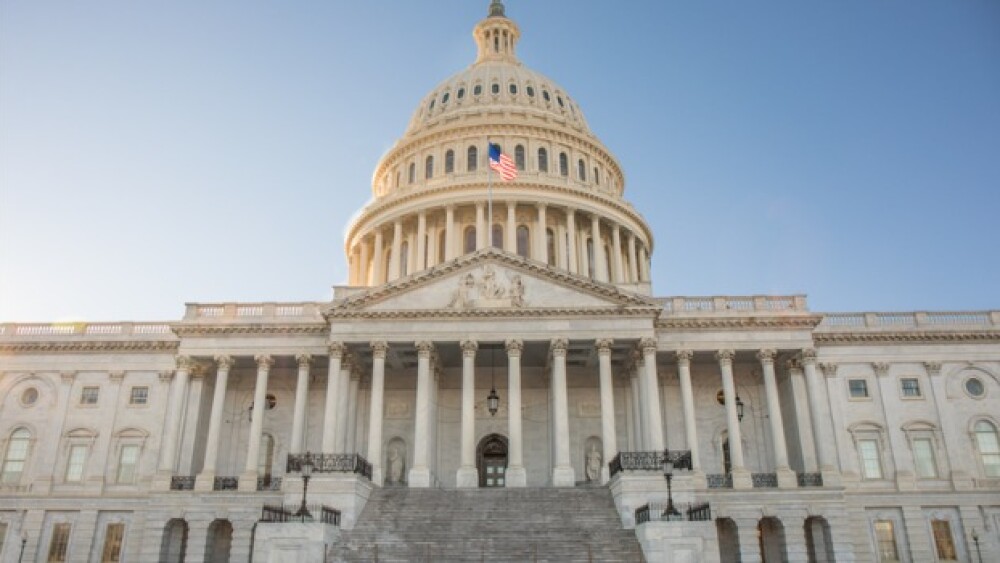The CEOs of BMS, J&J and Merck testified Thursday before the Senate health committee that pharmacy benefit managers bear much of the blame for high pricing, while declining to commit to price cuts.
Pictured: U.S. Capitol Building, Washington DC/iStock, Becky Wright
The CEOs of Bristol Myers Squibb, Johnson & Johnson and Merck testified Thursday before the Senate health committee, defending the high U.S. prices that Americans pay for prescription drugs compared to other countries based on patient value and the need to fund innovation and R&D costs.
Bristol Myers Squibb’s Chris Boerner, J&J’s Joaquin Duato and Merck’s Robert Davis were grilled for nearly three hours by Sen. Bernie Sanders (I-Vt.), chair of the Senate health committee, and other panel members. While Davis and Duato initially declined to appear at the hearing, both later agreed—under threat of subpoena—to join Boerner to testify in the hot seats.
Sanders told the three CEOs that their lifesaving drugs “mean nothing” to millions of Americans who cannot afford them and that the U.S. government “does not regulate drug companies, with very few exceptions” while the drug companies “regulate the United States.”
Senators from both sides of the aisle pointed to pricing examples for each company, including the fact that Americans pay $6,900 a year for Merck’s Januvia, while Canadians get the same product for $900. In addition, the hearing noted that J&J’s Stelara price tag is $79,000 a year in the U.S. but only $16,000 in the U.K., while BMS’s Eliquis is $900 for Canadians but $7,100 for Americans.
The hearing highlighted the committee’s majority staff report which found that the three companies charge Americans, by far, the highest prices in the world for prescription drugs. BMS, J&J and Merck “are not just charging higher prices in the U.S. compared to other countries” but “are also charging Americans much more than they did in the past,” according to the report.
The report notes that from 2004 to 2008 the median price of new innovative drugs sold by the three companies was $14,000. Even accounting for inflation, that number rose from 2019 to 2023 to a median price of $238,000 for new drugs.
All three CEOs testified that the high cost of drugs is needed to support the massive cost of bringing a drug through clinical trials, the average cost now being upwards of $2 billion, J&J’s Duato said. He also pointed out that over 90% of drugs that enter clinical trials don’t make it to approval. J&J has spent close to $78 billion in R&D since 2016, he added.
Merck‘s Davis anticipates the company spending $18 billion in R&D from now into the 2030s. BMS has spent over $65 billion in R&D over the last decade, Boerner said.
However, Tuesday’s report from the Senate health committee points to the enormous profitability of the three companies, citing massive stock buybacks and CEO salaries. According to the committee, the companies’ most popular drugs made more money on U.S. sales than the rest of the world combined.
The U.S. healthcare system shouldered much of the blame from the pharma executives and some of the senators acknowledged its complexity as a key cause of high drug prices. While each of the companies pointed to their rebate programs for patients with high out-of-pocket costs, the three CEOs said much of those savings aren’t reaching the actual patients as middlemen—pharmacy benefit managers—negotiate discounts on behalf of insurers and don’t pass along savings to patients.
Sen. Chris Murphy (D-Conn.) called out the “free rider syndrome” in which the U.S. is paying higher prices to allow other nations to receive lower prices. In response, Duato said, “The real difference is that in the U.S., patients get access to therapy, lifesaving therapy years before they do in the countries that you mentioned.”
The CEOs contend that Americans also have better access and availability of new drugs, and these countries “cost savings” come at a price. Boerner said often Canadians are waiting three-and-a-half years to four years to access medications that are already available in the U.S.
Duato said that over six years J&J’s drug prices have declined by almost 20%—over 40% with inflation adjustments. He was the only one of the three CEOs to commit to some kind of a price cut, testifying that J&J will lower the list price of Stelara when generic competition enters the market in 2025.
Davis and Boerner made no such commitments, but both said they would welcome cheaper generics when their drug patents expire. Boerner said generics allow a company to reallocate resources from that product onto the next wave of product innovation.
At the same time, the three companies were accused at the hearing of taking advantage of the patent system to delay generic entry to the market. Sen. Maggie Hassan (D-N.H.) pointed to Keytruda’s 168 patents currently on file. Half of the drug’s patents relate to Merck’s manufacturing process, as opposed to the drug itself, Hassan said.
Kate Goodwin is a freelance life science writer based in Des Moines, Iowa. She can be reached at kate.goodwin@biospace.com and on LinkedIn.






